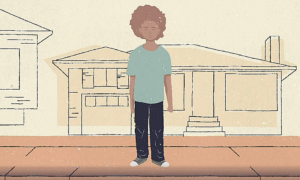 KONSTANTINECHRISTIAN/SHUTTERSTOCK
KONSTANTINECHRISTIAN/SHUTTERSTOCK
When Mary (name changed for anonymity) first entered the foster care system, she was a preteen who was ripped from her home and was about to be pulled away from her younger siblings. Police officers and social workers dragged them to a foster care center where they found separate foster homes for each.
As they were about to be placed, Mary desperately took the lead to say that she and her siblings were to remain together. “Then you’re going to have to wait here for hours until we can find someone who would be willing to take all three of you in, but don’t count on it,” a social worker grumbled.
Mary’s siblings clutched onto her and their eyes, filled with tears and terror, fixed on hers. It was then that Mary knew that, despite her own fear, she had to be the one to find the courage to sternly advocate for and plead to keep them together. She said they would wait as long as it took for them to be placed together.
According to the Child Welfare Information Gateway in 2019, more than two-thirds of foster youth in the U.S. have siblings. It’s a challenge to keep track of how many of them are separated from their siblings since siblings are often placed in foster care at different times and there are many half- and step-siblings.
However, research indicates that over 50% of foster youth with siblings are separated from one or more of them. Many potential foster homes have limited room for foster youth and cannot take in pairs or groups of siblings. The decision to either keep siblings together or separate is left up to social workers, and many times, social workers do not have the time and resources to find a foster home that will accept groups of siblings.
This issue was first addressed in the Fostering Connections to Success and Increasing Adoptions Act of 2008, which aimed to place foster children in the same homes as their siblings. However, its vague wording has allowed crucial decisions about foster youth’s living arrangements to continue to be based on social workers’ discretion.
Mary and her siblings were more likely to not be lost in the tangled web of the system since they were siblings who entered the foster care system together and were old enough to communicate their wishes. Although they felt they had lost everything, they were lucky to have each other through foster care. This “luck” carried on throughout their lives.
Stability, bonding are benefits
Numerous researchers have found that keeping siblings together positively affects foster children’s future success along with its immediate benefits during foster care home transitions. Sibling togetherness provides assurance and stability in the midst of transitioning from home to home.
Siblings benefit from living together in a foster home because they offer one constant in their drastically changing living circumstances. Sibling togetherness also provides emotional support and the feeling of being safe within the conditional foster caretaking business. Researchers emphasize the need for the unconditional love that sibling togetherness fulfills that siblings often do not receive from their foster caretakers.
Studies have also found that the academic performance of siblings who lived separately was lower than that of those who lived together. Siblings who are separated experience physical and emotional loss. They undergo a “loss of family stability.” Extensive research has shown that siblings who are separated struggle with their sense of identity, self-esteem and experience a loss of their sense of safety.
A few researchers argue that placing siblings in a foster home together is not always the best option. Researchers on abusive relations between siblings argue that some siblings must be separated for them to live healthier lives, but also accept mediation and therapy between rivalrous siblings as an option.
A crucial part of this perspective involves advice on how to assess whether or not siblings should be kept together. The main justifications of why siblings should be separated include if there is an observed conflict between siblings and if there is an inability to quickly find foster homes that are willing to take in groups of siblings.
Another researcher essentially supports the argument that some siblings should be separated, but from another angle. He says sometimes siblings constantly remind each other of their traumatic past, which is emotionally unhealthy for them. I argue that although siblings may think more about the arduous experiences they went through when living together, this reflection does not necessarily have a negative impact on them. Addressing the issues may be healthier than keeping them to themselves. Discussions between siblings can help resolve or mitigate their pain and facilitate perseverance and wellness.
Mary and her siblings do not shy away from talking through their past pain with one another. Their strong sibling bond seems to mediate the relationship between their trauma and their expression of internalizing symptoms. Had they been separated, they would not have had this powerful bonding experience amid chaos. They would not have gotten to revel in the cathartic experience of turning tears into laughter by using shared humor to heal. Recalling their memories of a shared past allows them to dive into deep discussions on how to help other sibling pairs or groups.
Mary and her siblings had each other to lean on and to strengthen and build each other up. They developed a strong sense of identity and self-esteem together. They found themselves in each other, and they see themselves in the foster youth of today.
Currently, the law provides that “unless it is contrary to the safety and wellbeing of the siblings, reasonable efforts must be made to place siblings together.” I argue that sibling togetherness should be a first priority and the first order of law when placing children and that the law must go beyond reasonable efforts toward placing siblings together.

Gabriella C. Herrera
There should be a new regulation with more precise and detailed wording that mandates social workers to find foster homes for groups of siblings to live together. Social workers should seek out siblings, develop an efficient database for siblings, devote more time and effort to finding foster parents who will take in groups, reserve those parents who are willing to take in groups only for sibling groups and provide informative presentations to encourage prospective foster parents to take in sibling pairs or groups.
Also, California, which currently only permits two children per bedroom, and New York, which currently only permits three children per bedroom, should follow suit of the 17 other states that permit four children per bedroom. All states should go even further by allowing more than four children per room if there is enough space for more beds to fit, because such regulation changes would provide for more opportunities for sibling groups to be placed together.
Prospective foster parents who are willing to take in sibling groups should not be prevented from doing so because of the number of rooms in their home if they are willing to take them all in; more exceptions should be allowed so that siblings can remain together. Furthermore, to expand the pool of parent candidates, all states and adoption agencies, including religious ones, must be inclusive of single parents, LGBTQ parents, and cross-cultural and international adoptions.
***
Gabriella C. Herrera graduated from the University of California Berkeley sociology program and is an incoming law student. She is passionate about empowering disadvantaged youth through writing and legal advocacy.
***
Editor’s note: This article’s headline was changed on Sept. 14, 2022.































